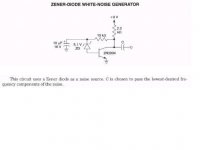Has anybody used any of the Homedics sound machines for a white noise generator? That have white noise and several other noises on them.
I see them at the thrift shops for $1-$2 each which is probably less than you can build one for. Thanks.
I see them at the thrift shops for $1-$2 each which is probably less than you can build one for. Thanks.
I bought it for $1.68.
It makes other sounds as well like a brooke running, birds chirping, rain falling.
I'm thinking that this will not disturb my neighbors as much when I am testing a high power amplifier on my back patio as a tone oscillator does.
And they won't call the cops on me.
It makes other sounds as well like a brooke running, birds chirping, rain falling.
I'm thinking that this will not disturb my neighbors as much when I am testing a high power amplifier on my back patio as a tone oscillator does.
And they won't call the cops on me.
Thanks Kev...
but have you seen what the MM5837 chips are going for on Ebay????
YIKES!!!!!! There's one for $10 and another for $23!!!!!!
Unbelievable!!!!!
but have you seen what the MM5837 chips are going for on Ebay????
YIKES!!!!!! There's one for $10 and another for $23!!!!!!
Unbelievable!!!!!
Thanks RJM...
I built one of those before but using an op amp for the amplifier. I didn't think it worked very well.
But from the National Semiconductor 1980 Audio/Radio manual page 2-62 it states:
Unlike semiconductor noise sources, the MM5837 provides very uniform noise quality and output amplitude.
The MM5837 uses a clocked shift register to generate noise which I thought was a much better approach.
I built one of those before but using an op amp for the amplifier. I didn't think it worked very well.
But from the National Semiconductor 1980 Audio/Radio manual page 2-62 it states:
Unlike semiconductor noise sources, the MM5837 provides very uniform noise quality and output amplitude.
The MM5837 uses a clocked shift register to generate noise which I thought was a much better approach.
Long time ago I used a electrolytic cap reversed, and wired with a high resistance in series, limiting current so some microamperes, and acting as load, and using a 1 uF 50V powered from 12V, and it works very fine.
Hi,
I reverse engineered the internal circuit of I think the MM5837 and then built a version from shift registers (from memory I think that it's 17 stages) and Exclusive OR gates for generating a psuedo random digital signal. Used for testing Motorway 'Information' sign communication signals. The signal appeared pretty random on the valve oscilloscope that I used. I guess that up to the clock frequency it is a good white noise source.
I reverse engineered the internal circuit of I think the MM5837 and then built a version from shift registers (from memory I think that it's 17 stages) and Exclusive OR gates for generating a psuedo random digital signal. Used for testing Motorway 'Information' sign communication signals. The signal appeared pretty random on the valve oscilloscope that I used. I guess that up to the clock frequency it is a good white noise source.
A 604K resistor and just about any FET op-amp (or a JFET follower for that matter) makes a nice 100nV/root-Hz white noise.
A 604K resistor and just about any FET op-amp (or a JFET follower for that matter) makes a nice 100nV/root-Hz white noise.
😀
Temperature compensation is left as an exercise to the reader....!
At one time I was looking for highest noise volts out for minimum microamps in and I wound up with 1M into a revered biased 3904 base emitter junction feeding a mu follower. Drawback is you need at least 10V supply to make it practical. More than a 9V battery except brand spanking new, anyway.
Last edited:
😀
Temperature compensation is left as an exercise to the reader....!
Pretty weak variation around room temperature, though in the UK it is probably noticably lower.
The chip's output is "uniform" because it repeats every couple of seconds. If you measure its peak output for a few seconds, you've measured the highest peak output it will ever give. It's like a two-second tape loop of recorded noise that gets played back over and over (once you hear it loop through a few times it actually SOUNDS like a two-second tape loop of recorded noise). This can be useful when you want to make the noise drive something to just below clipping, and need to know that it will never clip. With an analog noise source it may eventually clip, as the level is "truly" random and you don't know what the peak may be.I built one of those before but using an op amp for the amplifier. I didn't think it worked very well.
But from the National Semiconductor 1980 Audio/Radio manual page 2-62 it states:
Unlike semiconductor noise sources, the MM5837 provides very uniform noise quality and output amplitude.
The MM5837 uses a clocked shift register to generate noise which I thought was a much better approach.
Here's a description of a PIC microcontroller replacement:
White Noise Source based on PIC 12F processor
The PIC code described is "better" in that it has a much longer period, but once gain that's not always what you want.
- Status
- Not open for further replies.
- Home
- Design & Build
- Equipment & Tools
- White Noise Generator
